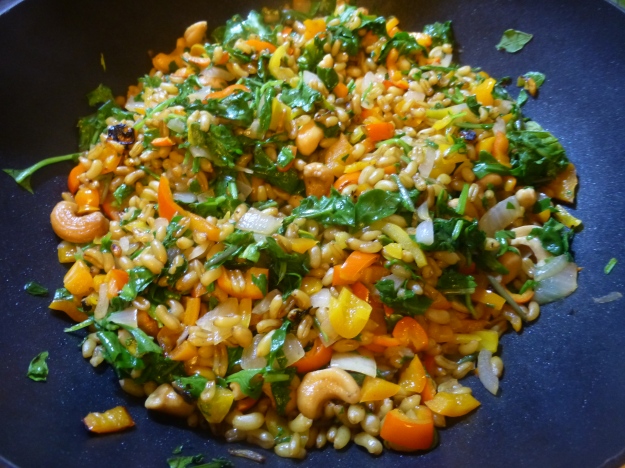
The bride’s keen on grain bowls lately, and I’m about 47.8% less enthusiastic about quinoa than she is, so I have been poking around for alternatives. While at the store, ostensibly to pick up some farro, I saw this thing in the grain section that looked like a sibling (of farro’s, not of mine): Kamut®. I had no idea what Kamut® was, but that didn’t stop me from bringing it home like a stray culinary puppy. Long story short, it’s a variety of wheat, whose journey out of Egypt was perhaps less tortuous than, but nearly as interesting as, the Jews’.
Allow me to quote from the trademark owner’s website:
-
The story of KAMUT® Brand khorasan wheat began in 1949, when Earl Dedman, a US Airman stationed in Portugal, received some unusual looking grain from a friend who claimed to have taken it from a tomb in Egypt. More likely, the friend had purchased it from a street vendor in Cairo, Egypt with the story that it had come from an ancient Egyptian tomb. Earl sent thirty-six kernels of the wheat to his father, R. E. Dedman, a farmer near Fort Benton, Montana. Within six years, the elder Dedman had grown the small number of seeds into 1,500 bushels, calling it “King Tut’s Wheat.”
In 1977, it fell into the hands of Robert Quinn, who tried unsuccessfully to get the people who make Corn Nuts to manufacture a wheat version of the snack with this grain. But Quinn and his dad continued to grow it on his family farm, which went completely organic in 1989. The following year, the USDA recognized the grain as a protected variety officially named “QK-77,” and the Quinns registered Kamut® as a trademark to guarantee that the original grain would remain unmodified and always be grown organically. From there, it got licenced to dozens of producers and is used in products from cereal to pizza… to this grain bowl.
This recipe follows a general formula I’ve developed for grain bowls: grain, some roasted/pan-fried vegetables, an element to add at least a bit of crunch to the texture, wilted greens for a little bitterness, some salt, and an acid (tomatoes, lemon juice, vinegar, or, in this case, toum) as a brightening agent. Please don’t shackle yourself to this recipe! It was created and modified on the fly, riffing on literally dozens of other options I sifted through from Pinterest pages and Google searches.

Instant veggie stock enhances the water.
A NOTE ON COOKING KAMUT®: A little searching on the Internets yielded some insight on how to cook it in an Instant Pot. Much like dried beans, the typical method for preparing Kamut® is to soak it overnight in water (or, in my case, vegetarian bouillon), but I didn’t have the time for that, and I — quite fortuituously — did have an Instant Pot. Much thanks to cookbook author Kathy Hester, whose The Ultimate Vegan Cookbook for Your Instant Pot: 80 Easy and Delicious Plant-Based Recipes That You Can Make in Half the Time yielded the info that if you press the “Adjust” button once after having set the Instant Pot up on the “Multigrain” cycle, “it will look like it’s going to cook for a normal 60 minutes. But on this setting — only on the multigrain 60-minute cycle — the grain first gets a 45-minute warm water soaking before the 60 minutes pressure cooking time. It’s great for Kamut® and other long-cooking grains.” If you don’t have one of these marvelous devices, you can just soak the grain overnight and prepare it according to the directions on the package. That method works just fine, even if it’s a little (well, a lot) longer. [Reminder from Russ Parsons, former LA Times food editor: “Rinse thoroughly. I mean thoroughly. In a strainer under running water.”]

One cup of dry Kamut® looks like this when cooked.
A NOTE ABOUT TOUM: Toum is a garlic-based Lebanese dipping sauce not far removed from aioli or the Ligurian agliata. The best recipe for it that I’ve found is at the Tori’s Kitchen website (she even thoughtfully includes step-by-step photography). If I deviate from her recipe at all, it’s usually to add more garlic, the cowbell of the pantry. There’s just never enough. When you’re making it, be sure your water and lemon juice are really cold, or the sauce might break up. But it’s super tasty, simple to make, and you will discover a million applications for it, from grilled veggie sandwiches to tater tots to pasta.

A Cuisinart full of toum.
Vegan Kamut® Bowl With Peppers, Greens, and Toum
INGREDIENTS:
For the grain:
1 cup / 225g dried Kamut® khorasam wheat
3 cups / 700ml water
1 tbsp. / 15ml Better Than Bouillon Seasoned Vegetable Base (or other vegan bouillon cube)
For the bowl:
2 cups / 325gm cooked Kamut® khorasam wheat
12 baby bell peppers or 2 medium sized regular bell peppers (red/orange/yellow, chopped)
1/2 onion, finely diced
5 oz. / 1 cup / 150g cashews, preferably roasted and salted
sea salt to taste
5 oz. / 140g coarsely chopped greens (this time it was kale, baby spinach, and arugula)
2 tbsp. / 30ml olive oil
For the toum:
3 1/2 – 4 cups / 700ml sunflower or canola oil, chilled
1/2 cup / 70g / about 1 head peeled garlic cloves
1/2 cup / 120ml lemon juice, divided
1/2 cup / 120ml ice cold water, divided
1 3/4 / 10g tsp salt (preferably Kosher salt, fleur de sel, or sea salt)

I was generous with the toum.
INSTRUCTIONS:
Cook Kamut® according to instructions (see A NOTE ON COOKING KAMUT®, above). Set aside.
Make toum according to instructions (see link in A NOTE ABOUT TOUM, above). Set aside.
Chop onion and bell peppers, place in bowl, and set aside. Meanwhile, heat olive oil in large pan on high heat until just about smoking. Add cooked Kamut® and toast, stirring occasionally, about 5 minutes or until slightly browned. Lower heat to medium and stir in onion and peppers. Cook for about 8-10 minutes, or until veggies have softened, stirring occasionally. Meanwhile, wash and chop greens. When vegetables have softened, add chopped greens and stir until wilted. Add cashews, stir, and salt to taste. Top with toum and serve. Serves 2-3 as main or 4-6 as side dish.
